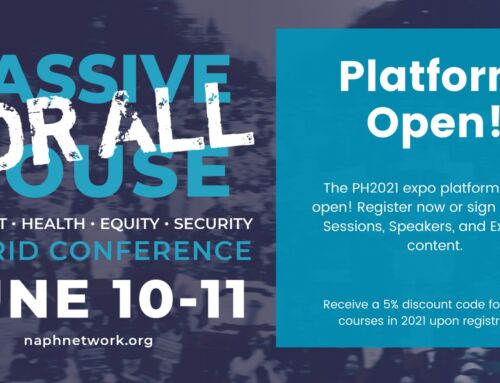The new PHPP Course, called Using PHPP in Passive House Design and Certification, will now be available on-demand online for American Passive House practitioners.
The Passive House Network has announced the launch of a Passive House Planning Package (PHPP) course as an online, on-demand, training for Passive House home design and construction. The PHPP is used by architects, engineers, consultants, and contractors – as an integrated design and construction tool.
“When we look to drive down building carbon emissions and make more robust and equitable outcomes, the PHPP energy model is the organizing tool that makes it all possible,” said Ken Levenson, PHN Executive Director. Levenson noted, “The PHPP is an Excel-based tool that allows the designer to simulate the behavior of the building both during ‘peak’ times – winter and summer – and over an entire year. It’s a flexible, easy-to-use model that allows for quick iteration and design alternate evaluation.”
The PHPP course is self-paced, allowing participants to repeat and review sections as needed to fully absorb the lessons. It offers 24 AIA continuing education credits. The training is organized around 9 learning objectives that give students a thorough grounding in PHPP practice for homes, and include:
- Learn the structure, inputs, and outputs of PHPP software
- Select and input appropriate climate data sets in PHPP
- Measure and record building characteristics (areas, volumes, etc)
- Specify building assemblies and components
- Model HVAC systems
- Assess building heat loss, energy demand, and summertime overheating risk
- Understand proper sourcing of performance data
- Gain practical experience in completing a PHPP assessment for a residential development
- Intended Audience: Architects, developers, self-builders, and other building professionals.
The course was developed in collaboration with Peel Passive House Consulting Ltd. Founder, Andrew Peel stated, “We are excited to help offer this course to Passive House practitioners across the US and North America because understanding and working with the PHPP is essential to making effective Passive House buildings.”
The course, Using PHPP in Passive House Design and Certification, is part of a larger Passive House education pathway, that begins with introductory classes, including a suite of on-demand introductory topics offered by the Building Energy Exchange (BEEx), based in NYC, the core Certified Passive House Designer and Certified Passive House Tradesperson courses, and other specialized expert training, all organized to build on each other and support growing high-performance competency as we work to make buildings a solution to our climate, health, and social crises.



